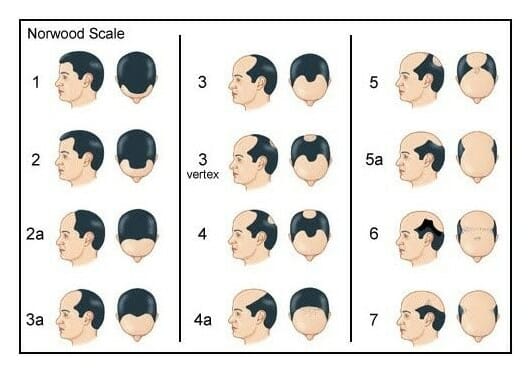If you are one of the many people with thinning hair or hair loss, you are not alone. Male and female hair loss is extremely common, but it's particularly common in men.
For many men suffering hair loss, they may want to consider non-surgical treatment options to slow down hair loss and reverse it. Whether you require medical treatment or surgery to restore your hair, The Treatment Rooms are able to consult you on various solutions to help you with your level of hair loss.

What is male hair loss?
Male hair loss affects around 80% of men over their lifetime and about 50% of men over the age of 50.
Hair loss, known medically as alopecia, may cause people to lose hair on just their scalp or their entire body. Sometimes hair loss can be temporary, but other times it can be permanent.
Losing hair is not usually something to worry about, but some people find it distressing. Treatments may help improve hair loss, depending on its type.
What causes hair loss in men?
It is normal to lose hair. Most people tend to shed around 50–100 hairs every day. People do not usually notice their hair falling out because new hair grows simultaneously, but when there is no longer new hair to replace the hair that falls out, hair loss occurs.
Reasons for hair loss typically include:
- Family history: Hereditary hair loss is the most common cause of hair loss. It means that someone has inherited genes that cause their hair follicles to shrink, and they eventually cease to grow hair.
- Age: Hair thinning occurs naturally with age. Over time, hair growth slows down, and the hair follicles stop growing hair altogether, which results in thinning hair on the scalp.
- Medical conditions: Several medical conditions may cause hair loss, including alopecia areata, scarring alopecia, a recurrent hair-pulling disorder known as trichotillomania and an underactive or overactive thyroid.
- Scalp conditions: A scalp infection, such as ringworm, or scalp psoriasis can lead to hair loss.
- Medications: Some medications doctors prescribe for arthritis, heart conditions, depression, high blood pressure, and gout may have side effects that cause hair loss.
- Cancer treatment: Having chemotherapy or receiving radiotherapy, particularly to the head and neck areas, may cause hair loss within weeks of starting a course of treatment.
- Stress: During times of extreme stress, people may notice temporary hair thinning.
- Sexually transmitted infections (STIs): Without treatment, an STI, such as syphilis, may cause patches of hair loss on the scalp, eyebrows and facial hair.
- Nutrient deficiencies: Being deficient in certain nutrients, such as iron, zinc, or biotin, may cause noticeable hair loss.
Thinning hair occurs naturally as people age, and it tends to be more common in men than women. However, if a person is losing significantly more hair daily, they may have a medical condition that needs assessing by their Doctor.
Types of male hair loss
Several types of male hair loss exist. However, male pattern baldness is the most common type in men, affecting up to 80% of males by the age of 80. Male pattern hair loss has characteristics such as thinning hair at the crown of the head and a receding hairline.
Types of male hair loss include:
- Male pattern baldness
- Alopecia areata
- Telogen effluvium
- Traction alopecia
Hair loss treatment for men
In some cases hair loss requires no treatment and resolves after a period of a few months.
In patients who have male pattern baldness, there are a variety of surgical and non-surgical hair loss treatments. A dedicated and specialist hair loss clinic like The Treatment Rooms London can provide a range of treatment options, many of which are simple and non-invasive.
Non-surgical hair loss treatment for men
At The Treatment Rooms, we offer non-surgical treatments as a first-line recommendation for hair loss in men. Non-surgical treatment options include:
Minoxidil - is a hair loss treatment available as a foam or liquid solution that men can use on their hair and scalp twice a day.
Minoxidil may help slow the rate of hair loss and promote hair regrowth by:
- Reversing follicle miniaturisation
- Stimulating hair follicles from the resting to the hair growth state
- Extending the growth phase of the follicle
Finasteride - At The Treatment Rooms, we can prescribe a hair loss treatment called Finasteride
Finasteride works by blocking the enzyme 5α-reductase, which converts testosterone to DHT. By decreasing DHT levels in the scalp, Finasteride reduces the effect of DHT on the hair follicles, which reverses hair thinning and helps to stabilise any further hair loss.
If you are currently taking Minoxidil and/ or Finasteride and have successfully stabilised your hair loss you may want to restore hair in areas you have lost it with a hair transplant procedure.
Patients who are actively losing hair at a rate that is not controlled are unfortunately not candidates for hair transplant surgery and should consider taking one or both of the above medications before making plans for surgery. The reason for this is that hair transplant surgery recreates hair in a new area that is potentially permanent. If the underlying process driving hair loss in the rest of the scalp is not controlled, patients may be left with their transplanted hair and no hair elsewhere on the scalp.
If non-surgical treatments are unsuccessful, our Surgeons can meet with you to discuss your suitability for a hair transplant.
Hair loss treatment for men
Surgeons carry out hair transplantation under a local anaesthetic, which means the patient is awake, but they do not feel any pain once the initial local anaesthetic injections have been carried out.
There are two types of hair transplants for men: follicular unit transplantation (FUT) and follicular unit excision (FUE).
The FUT hair transplant, also called linear strip excision method involves the following:
- A surgeon removes a thin strip of skin containing hair from the back of the head.
- They divide the strip into pieces, known as grafts, containing 1–4 hairs.
- A surgeon makes small incisions in the scalp and places the grafts.
- They stitch the area where they removed the hairs.
The FUE hair transplant method involves the following:
A surgeon extracts each healthy follicle individually from the back and sides of the scalp.
They relocate the extracted hair follicles to the receding hairline or crown using sub-millimeter techniques that puncture the scalp to transplant the hair follicles.
The surgeon uses specialist techniques to provide a natural and realistic appearance ensuring new hair growth blends with the existing hair's density, direction and angulation.
Where hairs have been taken out from the back and sides of the scalp, there will be dot-like scars, but these are not visible once the new hair grows.
At The Treatment Rooms, our surgeons specialise in FUE hair transplants due to the method achieving realistic results and having a shorter recovery time. FUE hair transplant results can last from around 15 years to a lifetime.
How our surgeons can help you
Several factors determine the best course of treatment following hair loss. Booking a consultation with one of our surgeons enables us to evaluate your hair and create a treatment plan that meets your needs.
At The Treatment Rooms, we tailor all of our treatments to each individual and provide a meticulous aftercare and recovery plan to give you the best chance of a result that you are proud of. Please contact one of our expert surgeons for more information and advice.
Authored by
Reviewed by
Dan’s Hairline Transplant
Type of Surgery : FUE hair transplant
Hair Loss Level : N/A
Number of Grafts : 1510
"If you are concerned about your hair, like a lot of guys are, getting in touch with The Treatment Rooms and making that change is the best thing I’ve ever done for my confidence"
Latest News
Does Vaping Cause Hair Loss?
October 20, 2024
Quick Summary: Does Vaping Cause Hair Loss? Vaping has rapidly gained popularity as a supposed healthier alternative…
Stem Cell Hair Transplants- What You Need To Know
October 12, 2024
Hair loss can be a distressing experience for many, affecting self-esteem and overall quality of life. Traditional…
Hair Loss in Asian Women: What You Need to Know
October 10, 2024
Hair loss is a concern that affects millions of women worldwide, and Asian women are no exception….
Book A Consultation













